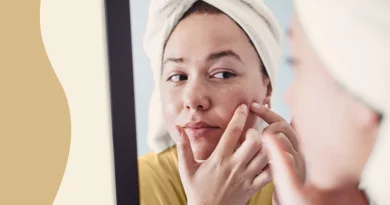6 Ways to Reduce Its Appearance
- It’s impossible to get rid of cellulite completely, but there are ways to reduce its appearance.
- Strength training can help build muscle and reduce weight gain, which may help prevent cellulite.
- Some topical treatments, home remedies, and procedures exist that claim to reduce its appearance.
- Visit Insider’s Health Reference library for more advice.
Cellulite is a common condition that looks like puckered skin. It is both harmless and painless. Often described as dimpled or bumpy flesh, cellulite is found predominantly in female bodies, especially in the butt, thighs, hips, and stomach.
“Studies suggest that cellulite is found in 80%-90% of women who have gone through puberty, so by that measure, it is a normal part of the body,” says Alicia Little, MD, PhD, assistant professor of dermatology at Yale University School of Medicine.
The dimpled appearance from cellulite happens when excess fat invades the fibrous tissues that separate fat from muscle.
What is cellulite?
Cellulite is an extremely common, normal part of the body where subcutaneous fat, the kind of fat that lies just under the skin, appears to be rippled, puckered, or dimpled.
Normally, you have cords, or bands, of fibrous connective tissue underneath your skin that are taut, giving the skin a smooth appearance. But sometimes excess fat will build up around the cords, which causes them to go slack, creating cellulite, says Tanya Kormeili, MD, a board-certified dermatologist in private practice in Santa Monica, California.
As fat pushes upward through the fibrous bands that connect the skin to the muscles, the fibrous tissue pulls the skin in, causing a lumpy appearance.
You don’t have to be overweight to have cellulite, though this is a common misconception.
While it’s impossible to get rid of cellulite completely, there are some ways you can reduce its appearance.
“None of these options will permanently get rid of cellulite because they do not address the root cause of it, which are the fibrous bands under the surface of the skin,” says Anne Chapas, MD, founder and medical director of Union Square Laser Dermatology.
1. Exercise regularly
Lack of physical activity can increase the appearance of cellulite. “Skin looks smoother and firmer over muscle rather than fat, so exercises that help replace fat with muscle can make cellulite less noticeable,” says Little.
Cellulite usually forms around the hips, thighs, and buttocks because people tend to have more fatty deposits in those areas, says Chapas. Here are some exercises that target those muscles:
Wayne L. Westcott, PhD, the chair of exercise science at Quincy College, also suggests hamstring exercises — such as leg curls and leg presses, or dumbbell step-ups or dumbbell lunges, to help keep cellulite in check.
Cardio alone cannot minimize the appearance of cellulite, so strength training and having a healthy diet are equally important.
2. Give yourself a deep massage
There is little evidence that massage can tighten or improve the appearance of cellulite long-term, says Kormeili. However, deep massage can cause inflammation and swelling, which may improve the appearance of the cellulite temporarily.
3. Exfoliate with coffee
There’s no real evidence exfoliating with coffee grounds helps reduce cellulite, says Kormeili. “However, caffeine does cause local constriction of blood vessels and the dimples may appear softer,” she tells Insider.
4. Try dry brushing
Dry brushing is a technique that involves using a brush with stiff bristles to brush the affected skin in long circles or strokes. Dry brushing does not reduce cellulite, but as with deep massage, the swelling it induces may help the dimples look softer for a short period of time, says Kormeili.
5. Apply retinol
As far as topicals go, applying retinoids at a 0.3% concentration for at least six months can have a thickening effect on the skin around the cellulite, making it look smoother, according to the American Academy of Dermatology. Kormeili cautions that results are modest.
Cellulite creams generally cost below $100.
6. Consider medical treatments
Talk to a dermatologist or cosmetic surgeon about your in-office options for reducing the appearance of cellulite. There are several types of treatments available at a range of price points:
- Injectable treatments: The injection of dermal fillers and collagenase enzymes may smooth skin irregularities due to cellulite. Dermal fillers like Radiesse cost about $900 and above, depending on the number of injections. Qwo, the first FDA-approved injectable treatment, is a new procedure with varying prices — up to several thousand dollars — depending on the cellulite’s severity. It dissolves the fibrous bands that cause dimpling.
- Energy-based procedures: Several sessions of radiofrequency, acoustic wave therapy, or laser treatments harness soundwaves or thermal and light energy to minimize the appearance of cellulite. Treatments like Velashape, Cellfina, and Cellulaze can range from $1,000 to $5,000.
Some other medical procedures recommended by the American Academy of Dermatology include vacuum-assisted precise tissue release and subcision.
What causes cellulite?
Though it’s unclear why some people are more prone to cellulite than others, factors that can increase the likelihood of cellulite include:
- Low estrogen levels: Cellulite becomes more prevalent during menopause when estrogen levels decrease triggering a subsequent reduction in collagen and fibers that give skin its elasticity.
- Pregnancy: Weight gain during pregnancy can make cellulite more visible.
- Genetics: Your genes play a key role in the overall structure, texture, and elasticity of your skin. And since skin elasticity is related to cellulite formation, it’s common for cellulite to run in families.
- Aging: The muscle loss, weight gain, and skin thinning that worsen as we age also increase the chance of cellulite.
- Diet: Cellulite appears to be more common among individuals with a diet that is low in fiber and high in refined carbohydrates and added sugars, says Debra L. Clancy RD, CD, a clinical dietitian at the Center for Weight Loss and Metabolic Surgery, UW Medicine.
How to prevent cellulite
Strength training combats muscle loss and weight gain, which is why it can be an effective preventative for cellulite as you grow older.
“Extra weight can make cellulite more noticeable, so getting to a healthy weight may reduce the amount of cellulite you can see,” says Little. However, in some cases, loose skin develops during
and cellulite can become more visible, she says.
The severity of cellulite is linked to being overweight, so maintaining a healthy weight by having a balanced diet may help you avoid cellulite. Refrain from yo-yo dieting, or rapid weight loss fluctuation, and moderately consume sugar-sweetened beverages, baked goods, and processed meats.
Dehydration also affects the appearance of cellulite, so drink enough water every day to maintain good health, manage body weight, and hydrate the skin.
Insider’s takeaway
Cellulite is a normal and common skin condition that causes a dimpled or rippled appearance on the skin. It’s unnecessary to get rid of cellulite unless you consider it a cosmetic concern.
Exercising and having a healthy diet can improve the appearance of cellulite, as well as topical agents, DIY remedies, injectable treatments, and energy-based procedures. However, they are only short-term solutions that cannot completely eliminate cellulite.
Overall, fitness may be the best option for reducing the look of cellulite, although results are neither guaranteed nor permanent.



